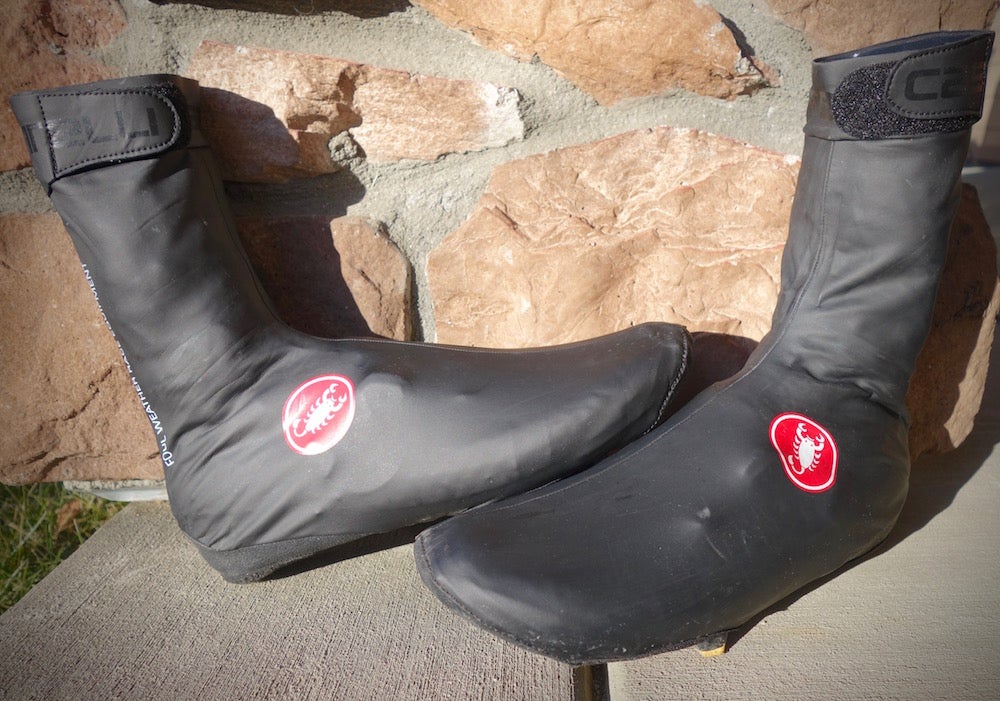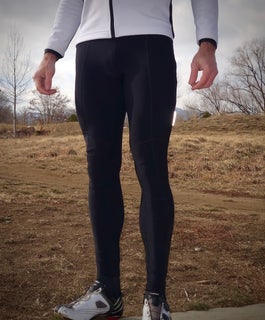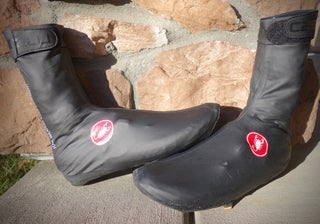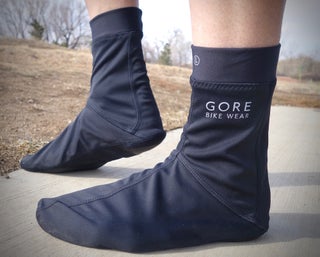3 Cycling Products To Keep Your Legs Warm In Winter Conditions

Pioggia 3 Shoe Covers from Castelli.
Happy (i.e. warm) legs and feet make for a happy ride. For those trying to build their bike fitness by hitting the road this winter, here are a few products that will help make those miles more enjoyable.
ROKA Cycling Pro Thermal Bib Tight

ROKA.com, $150
A good pair of bib tights is a must for winter riding. The Pro Thermal bib tight from ROKA uses two simple fabrics, one to keep you warm and the other keep you from heating up. Thermal fleece is used through the legs with multi-panel construction and articulated knees, helping it to move with you. For the shoulder straps, ROKA employs a simple mesh fabric to keep you from overheating. Zippers at the ankles make it easier to pull these on. What they don’t have is a chamois, so wearing a pair of cycling or tri shorts underneath is a must.
The combination of fabrics works well through a solid range of temperatures. With a pair of shorts underneath, the double layers keep your upper legs very warm, making them great on days when you maybe should have chosen the trainer instead. In less epic conditions, around 45 degrees, they do start to feel a bit like overkill due to the double layers. Though there are a lot of seams due to the many panels, we didn’t experience any chafing or irritation. Up top, the mesh is unnoticeable, which is a good thing in this case. The straps are wide enough to keep everything in place and not dig in.
The only nitpick would be that the thermal fabric could come up a bit farther up front to protect a bit more from drafts, but that’s a minor issue. For the price, these are useful to have on hand to get you through the season’s varying conditions.
Castelli Pioggia 3 Shoe Cover

Castello-Cycling.com, $45
The Pioggia 3 has a soft fleece lining to help keep your feet warm while the polyurethane-coated outer repels water. Also helping keep the water out are the sealed seams, waterproof zipper and silicone bead along the top.
Pulling shoe covers on is inherently a struggle, but the rear facing zipper is long and the big pull tab helps. The fabric stretches well over buckles or dials. Once on, the Poggia 3 scored high marks for keeping our feet dry. Water and snow visibly beaded up and ran off the covers. The fleece lining, while not super thick, did enough to keep feet warm mile after mile. While we haven’t put a full season on them, the reinforced bottom looks like it will hold up for a long time.
The only issue we ran into was a combination of the height and narrow opening. The extra height is fantastic for coverage, but combined with a tight opening, getting the zipper fully closed was a bit of a struggle. That said, once up it never came down.
Retailing at $45, these overshoes are a solid value that you will provide you with plenty of dry, warm miles.
Gore Universal Windstopper Socks

Goreapparel.com, $50
Going a different direction than others, Gore choses to go under the shoe, rather than over, to provide a windproof barrier of protection. Made of polyester with a wind-stopping membrane, these socks are surprisingly thin, with a slick—but comfortable—feel. A foot-specific shape helps take up any extra material to prevent bunching.
These socks feel a bit odd at first, but after a few miles we didn’t feel any difference between them and a standard sock. In temperatures between 40 and 50 degrees, these socks did the trick for us. Comfortable over long rides, the cold never quite got through enough to cause issues. Below 40, we noticed that our feet did start to get a little uncomfortable. Moisture management was solid, but the longer you ride, the more likely you are to have issues with perspiration. The cuff is high enough to slide under or over tights, and doesn’t look too awkward on their own.
Sliding the socks on is a bit tricky as there is not much stretch to the fabric. Pointing your toes helps when getting them on, and pulling a bit from the toe will help when peeling them off. Size wise, if you are in the middle of the range, choose the larger size as that will help with getting them on and off.
The only drawback is that they are not waterproof. If you think you will encounter wet roads or get caught in a storm, a waterproof shoe cover (see above) may be a better option.